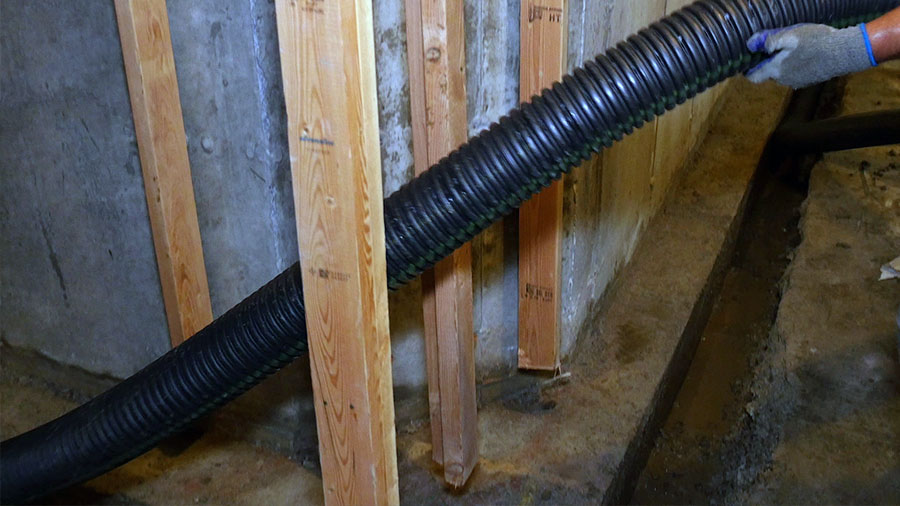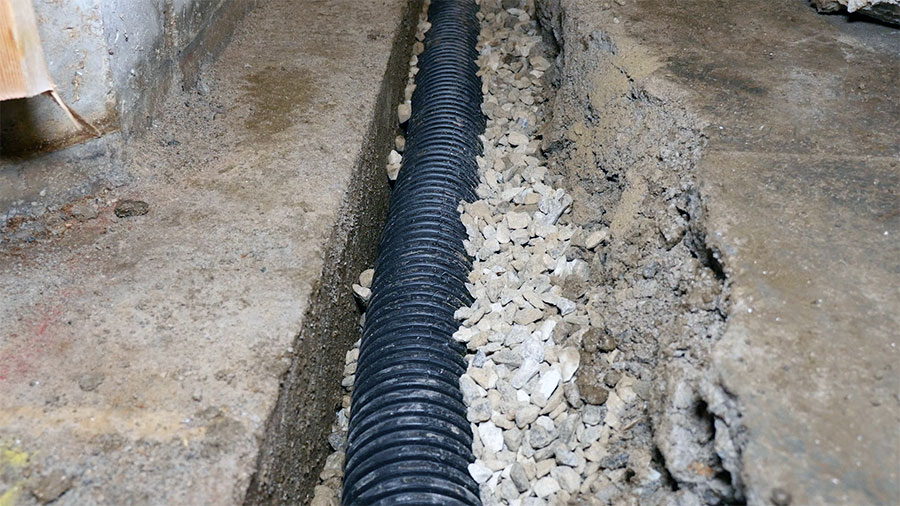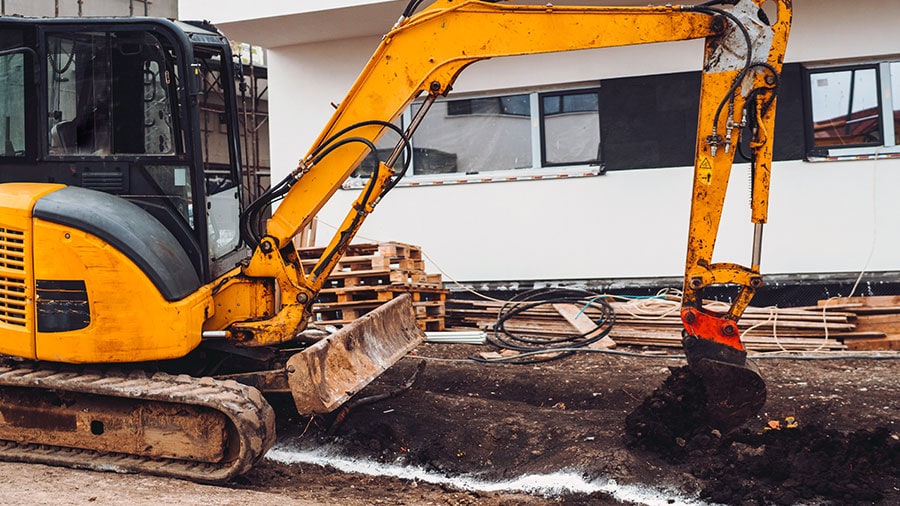Drain Tile Can Save Your Basement

Drain tile can save your basement from water leaks and floods. Drain tiles can effectively manage water levels in the basement, but the system’s success depends on proper installation and maintenance.
Table of Contents
What is Drain Tile?
Despite its name, drain tile is not tile at all. When used in the construction industry, it refers to the drainage pipe. Drain tile is a system of subterranean drainage pipes laid around the footings of a building.
Chances are if your home has a basement and has experienced flooding, someone has told you to get drain tile. But what is drain tile, and how does it help?
Essentially drain tile is a way to protect your home from groundwater flooding. It redirects water away from your home before it can enter and cause damage. It is one of those things you never need – until you do!
Increased runoff from urban expansion and more frequent severe weather systems make our homes more likely to flood. Investing in a drain tile system could save you from lengthy insurance claims and expensive cleanups in the future.
How Drain Tile Works
Water always chooses the path of least resistance, so drain tile offers the easiest path. The pipe used for drain tile is porous, so water finds its way into the pipe system rather than your home. Water is then directed away from your home using a combination of gravity and a sump pump.
Once in the pipe, the system directs the water to a dry well or releases it above ground to run off into a storm drain or sewage system.
The Origins of Drain Tile
Using drain tile has existed in agriculture for over 2000 years. Early civilizations used channels lined with clay tiles to divert excess water away from crops. This improved crop growth and yield better harvests.
However, it wasn’t until 1838 that this drainage system was introduced to America. A Scottish immigrant named John Johnson was the first to deploy the drain tile method on his New York farm. The results were astounding. His crop production surpassed all neighboring properties and drew considerable attention.
One particularly interested man was fellow agriculturalist Henry French. While Johnson pioneered drain tile, the French brought the idea to the masses. In 1859 Henry French wrote a book titled “Farm Drainage: The Principles, Processes, and Effects.” Following its release, the drain tile increased, so the system became known as French Drain. This term is still commonly used in agriculture today.
Outside of agriculture, drain tile is the term predominantly used. Other terms are also used and are interchangeable with the term drain tile. These include perimeter drain, perforated drain, foundation drain, rubble drain, weeping tile, and footing tile.
Drain Tile in the Construction Industry
Drain tile in the construction industry aims to prevent groundwater damage to a building. Drain tile gathers water from around a building and removes it.
There are two different types of drain tile systems – internal and external.
An internal system is when the drain tile pipe is installed inside of a building’s foundation beneath the floor slab. This is the more common option when retrofitting drain tile. It is also used in new builds along with external drain tile.
An external drain tile system is when the drain tile pipe is installed around the perimeter of a building below the level of the floor slab. This is the preferred method for all new builds, either with or without an internal drain tile. It is also possible to retrofit the external drain tile.
If you live in a recently constructed property, drain tile may already be installed. Building regulations nationwide now mandate the installation of drain tile whenever a home has a crawl space or basement. The only exception to this rule is if the home is built on naturally well-draining soil such as sand gravel.
Soil that drains well lessens the risk of future water damage but doesn’t prevent it. Installing drain tile is still advisable. The benefits far outweigh the initial installation cost and may make future resale easier.
Likewise, when purchasing your next home, especially an older home, ask if there is a drain tile system.

Types of Drain Tile
There are two different types of pipes used for drain tile.
The first is a rigid PVC pipe. At first glance, it resembles an ordinary drain pipe, but one side of the pipe has small holes to allow water to enter. When laying the pipe, the holes are placed face down so rising water enters the pipe. As with all rigid PVC pipes, you require corner fittings to change the pipe’s direction. The rigid pipe comes in lengths of 10 feet and costs approximately $8.95 per length.
The alternative to the rigid pipe is a corrugated flexible pipe. This pipe has small slits on all sides of the pipe. This allows water to enter from any direction, but sand, grit, and soil particles are mostly blocked. One recommendation to further protect the pipe from a possible blockage is a fabric sleeve can be used along with the pipe. We don’t recommend it. Filters are designed to be changed. They eventually get clogged. You will not be able to change the filter unless you dig up the drainage system.
The pipe costs approximately $0.89/foot. It is cheaper than rigid pipe and doesn’t need corner fittings because it is flexible. The pipe’s polyvinyl composition makes it durable in high temperatures and cold. It will not crack like the PVC pipe when a 2800+ pound car drives over it.
Regardless of the type of pipe used, it will usually be 4 inches in diameter. This is the industry standard for residential drainage, but other diameters are available up to 18 inches.
Laying Exterior Drain Tile
Drain Tile can be retrofitted for an older home, internally and externally, but installation during the build phase is best. It is ideal for laying drain tile in conjunction with the foundation footing of a new home. This gives maximum flexibility with the system design and keeps cost to a minimum.
When a building’s foundation is near completion, a deep trench is dug alongside the footings on the house’s exterior. Installers place the pipe in the trench and then cover it with washed stone. The stone must be at least 1/2 – 3/4 inch in size to avoid blockages and render the drain tile ineffective.
The stone is then covered with a layer of porous fabric, such as landscape matting. The fabric allows water but prevents soil from clogging up the drainage channel or the pipe. After the fabric is in place, it is covered in soil and brought to ground level.

Retro-fitting Drain Tile: Exterior or Interior
Although easier to install during construction, it is possible to retrofit exterior drain tile. The process is disruptive and costly but often resolves an ongoing water problem.
This method involves digging a drainage trench outside the building at the foundation level with a large backhoe truck. It is a labor-intensive process and causes considerable outside disruption. Removing features such as pathways, decking, and trees may be necessary to gain access to the foundation.
External installation takes considerable time, money, risk of structural damage, and short-term results with no long-term solution. Contractors will rarely offer a guarantee for over 10 years. Longer guarantees mean they have more confidence in their work.
The alternative is to use the internal method. This method causes internal disruption but is the most common method for a retrofit system.
Before installation, the basement area needs to be as empty as possible. Finished basements include the removal of floor covering and sheetrock along the bottom portion of the walls and any fixed cabinets. Unfinished basements don’t require as much prep work.
Once clear, all items are moved to the center of the room. Plastic sheets cover everything, including light fixtures and smoke detectors.
A perimeter trench and sump pit will be jackhammered out of the concrete foundation slab and below ground. This is a time-consuming and noisy process but much faster than exterior excavation. The pipe is then laid in the trench and will direct groundwater into the sump pit. The sump pump moves the water through a discharge pipe to the outside.
This is a very effective solution for older homes not built with foundation drainage.
Drainage Destination
As previously mentioned, the purpose of the drain tile is to direct water away from a building. Where and how we channel water depends on your geographic location.
Gravity is the perfect way to drain the water away if you live on a property with a significant slope. A slope of 1/4 inch per foot is the absolute minimum to consider for this method. Anything less will be ineffective. The slope method is a low-cost, highly efficient way to remove water.
If the gradient on your property is insufficient, you must use the collection method. This time the water collects in a sump pit in the property’s basement. From here, an electric-powered sump pump will pump the water away from the property.
The final destination can be a storm drain, sewer system, or dry well. When using a dry well, it is essential to place it significantly away from the property. This will prevent water from seeping back into the basement and cycling back through the system.

Exterior Drain Tile Drainage Issues
Even if you have drain tile installed around the exterior of your home, water issues can still occur. As with other drainage pipes, drain tile is susceptible to blockages. This may be due to tree roots or dirt and debris entering the pipe. Other causes include cracked pipes allowing water to flow back to the building or a malfunctioning sump pump.
Possible signs of a problem include:
- Water stains on the walls of your basement.
- Water is pooling in the basement.
- Mold
- Salt-like residue on basement walls (efflorescence).
- Puddles of water around the perimeter of your basement floor.
Contact a professional to investigate if you are experiencing any of these issues and cannot find an obvious explanation. Finding the source of the problem can be difficult and time-consuming, but the longer you leave it, the more extensive the problem will become.
Drain Tile Cost
The cost of installing drain tile can vary considerably. Many factors affect the overall cost. Professional or DIY installation, new build or retrofit, internal or external installation, rigid or flexible pipe, etc.
The most expensive option is to hire a professional. It does cost more, but you are paying for their expertise and experience. A professional installer will be quicker, and you will be less likely to experience future problems.
To install an outdoor drain tile at the new build phase, you can expect to pay anywhere between $50 and $80 per foot. The larger the drain diameter, the higher the cost. A good average to work with for budgeting is $70 per foot. This is at the higher end but should give a realistic figure for you to work with. That would mean you need to budget $3,500 for 50 feet of drain tile. This cost will increase from $25,000 to $50,000 to retrofit an exterior drain tile system for an older home.
DIY is always a cheaper alternative as you save considerable labor costs. There will still be material costs and equipment hire. The daily hire of a trencher is roughly $400 a day, and a compactor is about half of that amount. The DIY option will probably take longer, but you can complete the work in sections.
The costs are more reasonable if you have exhausted all the alternatives and are retrofitting the internal drain tile. You will need to budget up to $4500 using the “pitched” method and a sump pump. Basement access, size, and project complexity all impact the installation cost.
Hidden Costs
Both internal and external drain tile systems are designed to take the excess water away from your home. If the water can drain to an existing external drainage system, your additional costs will be minimal. However, if the water drains to another area on your property, you may need to install a dry well.
There are several types of dry good configurations made from various materials. The volume of water It needs to handle will dictate the type and size of dry well you will require. A professional may charge up to $3500 for an installation. The most you would expect to pay for materials and self-installation is approximately $500.
Wet basement? Schedule a free, no-obligation inspection and quote at no cost.